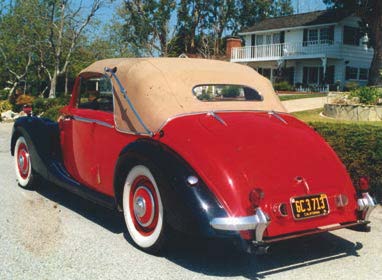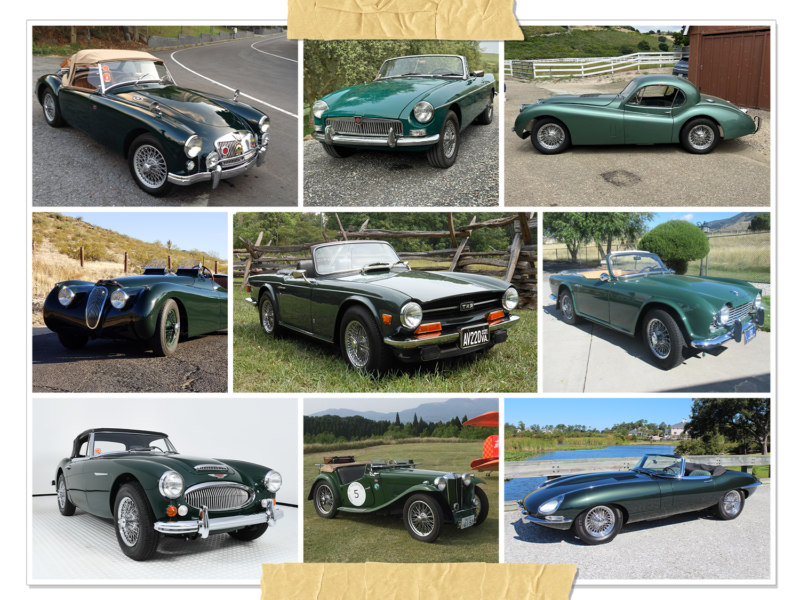Why we love ‘em, play with ‘em, and even occasionally drive ‘em
By Rick Feibusch
I have been a confirmed British car enthusiast from early childhood. It’s my Mom’s fault. I was one of those Dr. Spock baby-boomer babies (as opposed to a Mr. Spock, logical, Live-Long-and-Prosper baby) who could do no wrong and was actively encouraged at any and all interests, in order to enhance creativity. It might have worked! At three years of age I could name all of the cars on the streets of San Francisco.
Pioneer British car importer Kjell Qvale had opened his British Motor Car Distributors Ltd. dealership on California Street just after WWII and proceeded to fill San Francisco with hundreds of Austins, MGs, Hillmans, Rileys, and Jaguars. Qvale also brought in a number of British-built motorcycles and a few of just about every British marque (correctly pronounced “mark” as opposed to “marquis,” like in de Sade) available at the time.
Then there was the Dinky Toys display at King Norman’s Kingdom of Toys on Clement Street. Most toy stores had this cool wooden display with the whole Dinky line arranged on miniature steps. I would go over the complete line with Mom as she would read the names of the various cars, many of which we never saw in the States. Morris Oxfords, Standard Vanguards, Rover 60s and Riley RM Series saloons, along with the more recognizable MGs, Jags, and early Sunbeam Talbot/Alpines. I collected a few but learned them all.
This was just after WWII. There were no automotive imports from Japan, and the Germans were not yet importing VWs in large quantities. Mercedes were still generally viewed as Nazi staff cars, and the French and the Italians were about as active in the market as they are today. The British were pretty much the only game in town, and they provided a civilized yet classic and sporting look and feel that could not really be duplicated by American culture. (Our first true “sports cars” were the Thunderbird and the Corvette.)
American cars were generally new “streamlined” bodywork covering lots of prewar technology. It wasn’t about style, because there were some really beautiful American cars, and it wasn’t about performance, because many American cars could fly! A basic Ford coupe with a flathead V-8 would blow away most imports, and any Olds Rocket 88 could suck the headlamps out of the fastest of Fords!
On the other hand, British cars were built for an alternative universe where the roads were narrow and twisty and petrol was expensive. A place kind of like “The Misty Isles,” where the Sunday funny pages’ Prince Valiant lived, only with cars.
These cars were made from wood, leather, steel, and aluminum, and put together by skilled craftsmen with years of training and experience. The styling was “prewar-retro” because that was what the English people liked at the time. The most plebeian of British family sedans featured lines and details that were more in the spirit of prewar American luxury cars.
I was smitten! These were the cars for me! My first model car was a Revell “Highway Pioneers” MGTD. Mom “helped” me build it. She painted the seats with red nail polish and the plastic crinkled up like leather from the lacquer base. Cool! My dad took me to the road races in Golden Gate Park where the Cad Allards roared, the MGs buzzed, and the Jags, well, sounded cooler than anything I had heard before (or since, for that matter!).
So there you have it. We all are nuts for various reasons—and that is the reason that British car meets and club activities are so much fun. Many old car enthusiasts are not “joiners,” especially those of us who already march to the beat of a different drummer. Still, I encourage you to get out there and meet your British car-owning neighbors, take your car to the local “show & shine,” and drive your car on a rally or two.
Get out and let the world—especially the kids—see, feel, smell, and hear your British car. Remember your first time and try to promote these cars to the public. That’s where new enthusiasts come from.
At this point, restored and well-maintained cars should last forever. They are a labor of love. Let’s make sure that there will be someone here to love them after we’re gone.












'Spotlight on British Cars' has no comments
Be the first to comment this post!